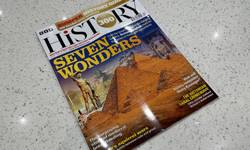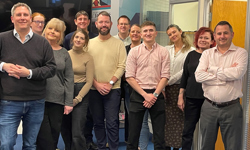NME is now a freebie and some of its newest launches have been digital only, but Time Inc UK CEO Marcus Rich says there’s never been a better time to be in the publishing industry.
His is a business that has seen some considerable change in its time; four of its titles were launched in the 1800s, and The Field reported on the Charge of the Light Brigade in 1854. Now, print remains at the heart of the company – Time Inc is home to some of the UK’s most iconic magazine brands – but there’s also live reporting on digital and social media, several digital-only brands, and the company is making a significant investment in video.
The ability to change with the times, led by people passionate about their markets, is what the Time Inc UK titles of today have in common with those more than a century old – and what makes Rich bullish on the future of print.
“Now is our time,” he says. “The reason I say that is the more you look into the data – the rise of ad fraud, the rise of viewability, the data that shows that by placing advertising in the correct context you get a better return. Brands need to consider not just the immediate but longer-term brand benefits; consumers have an overwhelming mass of content options, and all this lends itself to organisations that have outstanding and compelling content, and that have built up a deep passion and trust.
“People will migrate to proven and trusted brands that they believe have engaged with them and built up the required level of trust. I think that, particularly with the current onslaught of new, interesting but somewhat lightweight content sometimes from digital brands, ultimately, great content will win out.”
Time Inc’s print brands include Wallpaper*, Horse & Hound, TV Times, Ideal Home, Marie Claire and Country Life. It has several digital-only brands, such as the consumer electronics and IT reviews site TrustedReviews.com, acquired in 2007, and the casual gaming site Mousebreaker, bought in 2008. Its events include the Decanter World Wine Awards and the Country Life Fair. Technology is helping the company expand in the key sports it covers – equestrian, sailing and cycling – as it uses events and data to deepen its understanding of these growing areas.
The company was known for decades as IPC, and was bought by Time Inc, the publishing subsidiary of Time Warner, in 2001. The UK division rebranded last year as Time Inc UK. Rich says the change meant the business was in a stronger position to determine its own destiny and make strategic investments for growth. One such investment came in August this year, when the company took a stake in Snap Fashion, a visual search business specialising in fashion. It allows consumers to search, browse and purchase fashion items that are inspired by photos they’ve found online or taken on their mobile devices.
Rich joined the company in March 2014 and has a long history in UK publishing. He worked at Associated Newspapers from 2009 as managing director of The Mail on Sunday and deputy managing director of the Daily Mail, and became commercial managing director of DMG Media. He had previously worked for Emap.
Free thinking
Time Inc made headlines itself recently when it announced that the music title NME, which launched in 1952 as New Musical Express, was going to be distributed free of charge from September, through stations, universities and selected retailers. The title had seen sales sliding for several years, to a paid circulation of just 15,000; in its new, free format, it will have a circulation of 300,000. While music will be at the heart of NME, coverage will be broadened in the areas of film, fashion, TV, politics and tech.
Rich says there is no general plan to switch titles from paid to free circulation. “There’s not a broad-stroke strategy. The starting point is ‘who is the consumer, what’s the content they want and what is the best platform for reaching them?” he says. “Each market will have a different analysis of that.”
In the case of NME, he says the switch to free makes sense because the growing audience of millennial consumers has primarily accessed its content via desktop, mobile and social. It has 4.7 million weekly consumer contact points in this way, and by making the print product free, it gives the brand an opportunity to further extend its reach with a freemium model. The magazine and the business model have evolved along with the music industry and the way in which fans consume content.
In the 70s and 80s, for instance, music fans chose their music paper or magazine along almost tribal lines, to mirror the style of music they liked. Tastes were more exclusive because albums were expensive; now the digitisation of music and the rise of the singles market mean people can afford to have more eclectic tastes. “So, you can like Taylor Swift and you can like Wolf Alice,” Rich says. “The brand can cover more music across more genres; it simply focuses on what’s the best. Every brand, if it’s going to survive … has to change in line with the consumer.”
Several of Time Inc’s brands are digital only because, Rich says, that’s what suits the audience. He does not see that any of the brands currently in print will become digital-only.
“Yes, there are difficulties in print, but there’s also a lot of robustness in print. Country Life has had five ABC increases in a row.” While pop magazines and titles aimed at young women have struggled, those for an older, more upscale audience, are thriving.
“It’s evolution, isn’t it,” he says. “We’re not hidebound by being print publishers, in fact quite the reverse. The shackles have been freed, and I think there’s a growing set of data points that we understand instinctively that are now proving to be quantitatively true. The real killer point of engagement is about great content. And, quite frankly, who is better placed to generate better content than us (in the publishing industry)?”
Time Inc UK is one of the founding partners of Magnetic, a new marketing agency for magazine media in the UK. It exists to help advertisers get the very best return from the rich engagement opportunities offered by multi-channel magazine brands. Magnetic explores the value of magazine media and the unique way to deliver effective ROI for advertising partners, through research and creative collaboration with advertisers and agencies. The other founders are Bauer Media, Dennis Publishing, Haymarket, H Bauer, Hearst UK and Immediate Media.
Platform agnostic
While older consumers have grown up with magazines, and younger people tend to encounter Time Inc brands digitally in the first instance, Rich says reading is not losing its allure, and nor is the printed word. Different platforms simply serve different purposes. One of his own children’s hobbies is show-jumping, for instance; while they look online for news and event results, they want the latest copy of Horse & Hound every week because it provides the features they need to read to improve their own performance. The same, Rich says, applies to music fans, cyclists and everyone with a passion for something they want to know more about.
“People say ‘I like television, I like radio and I like newspapers, but I’m absolutely passionate about – whichever their hobby is’. There’s never been a better time to make sure that story resonates,” Rich says.
“The emotional context of reading still places it in a very strong position because you’re in an emotional position, where you’re ready to absorb information and get very deep and very passionate about it, and that still resonates.
“Millennials want content quick, but it doesn’t mean people are stopping reading. We know about the book market – it was all going to move to e-books, but that hasn’t happened. It just means you’ve got to be able to edit content in the appropriate form for the appropriate audience.”
Providing content anytime and everywhere in a format that suits the audience and the platform means work practices have gradually been transformed. The old editorial team who worked 9am to 6pm, with a flurry of activity leading up to press time, has gone. Now, there’s a content team working much longer hours to cover events live online, and create a broad range of other content for other platforms. Time Inc recently hired twelve videographers to creating video content for its brands.
“Brands have never had greater reach,” Rich says. “The contact points we have with consumers have never been bigger. The skill is clearly getting the right content at the right time in the right context. That’s the new challenge for the editor, which is different to just editing one platform.”
The ad lag
The balance of advertising revenue does not, as is the case with many publishers, reflect where the bulk of readership comes from, but Rich is confident it eventually will. “You do still have this ‘if you build it, they will come’ thing, which is that if the content drives an audience, then the advertisers will follow, but there’s a natural lag in terms of that journey,” he says. “There’s been a big shift from desktop to mobile and that’s not reflected in the ad revenue numbers. As each new platform comes along, you’ve got to get formats that have impact, and you’ve got to get relative ROI data to prove it.”
“Mobile is one of the great opportunities and one of the great challenges to content providers. It’s a primary platform and can we make sure the content really works hard on that platform for advertisers; part of that is definitely going to be native advertising. Clients, media owners and agencies are all converging around content.”
Consumers not only accept native advertising as part of how their entertainment is funded, but actually appreciate it for what it is, provided it’s done well, Rich says. “If I took home Marie Claire to my wife and I’d cut out all the ads, she’d say ‘why?’. The ads in that context are all part of the enjoyment, and native is just an extension of that. By putting it in the appropriate context, you’re actually enhancing the user experience. The old ‘church and state’ separation is somehow to suggest that any partnered content is somehow worse content, but actually, why would that be the case? If you’ve got the right people who understand the audience, they’re delivering added value.”
CEO: Marcus Rich
Newest brand launch: Equo, a competition entry system linked to Horse & Hound
Newest print title: Fit & Well, a women’s monthly
Best-known brands: Country Life, Woman’s Weekly, Wallpaper*, Marie Claire
Turnover: £279,578 million (2014)
Employees: Over 1,500












